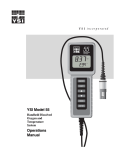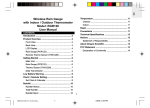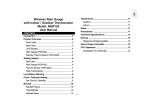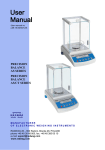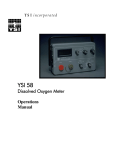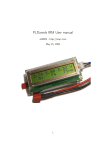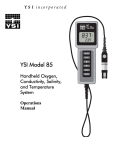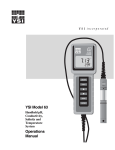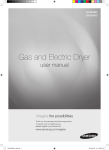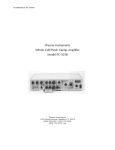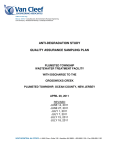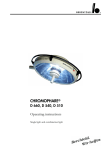Download YSI 95 Dissolved Oxygen Meter Instruction Manual
Transcript
YSI MODEL 95 Handheld Dissolved Oxygen And Temperature System Operations Manual CONTENTS SECTION 1 INTRODUCTION .........................................................................................................................................1 SECTION 2 PREPARING THE METER ........................................................................................................................2 2.1 UNPACKING .................................................................................................................................................................2 2.2 WARRANTY CARD ......................................................................................................................................................2 2.3 BATTERIES ..................................................................................................................................................................2 2.4 CALIBRATION/STORAGE CHAMBER ............................................................................................................................3 2.5 HAND STRAP ...............................................................................................................................................................3 2.6 THE METER CASE .......................................................................................................................................................3 SECTION 3 PREPARING THE PROBE .........................................................................................................................4 3.1 CHOOSING THE RIGHT MEMBRANE CAP .....................................................................................................................4 3.2 MEMBRANE CAP INSTALLATION .................................................................................................................................4 SECTION 4 OPERATION .................................................................................................................................................6 4.1 TURNING THE INSTRUMENT ON .................................................................................................................................7 4.2 CALIBRATION ..............................................................................................................................................................7 4.3 MAKING MEASUREMENTS ..........................................................................................................................................8 4.4 STIRRING .....................................................................................................................................................................9 4.5 SAVING DATA..............................................................................................................................................................9 4.6 RECALLING STORED DATA..........................................................................................................................................9 4.7 ERASING STORED DATA............................................................................................................................................10 4.8 TOGGLING BETWEEN %-AIR SATURATION AND MG/L...............................................................................................11 4.9 DISSOLVED OXYGEN FILTER .....................................................................................................................................11 4.10 DISPLAY BACKLIGHT ..............................................................................................................................................11 SECTION 5 PRINCIPLES OF OPERATION .............................................................................................................12 5.1 MEA CLARK OXYGEN SENSOR ................................................................................................................................12 5.2 DO READINGS FROM THE CATHODE REDUCTION .....................................................................................................13 5.3 FORMATION OF AGCL AT THE ANODE ......................................................................................................................13 5.4 FUNCTION OF THE ELECTROLYTE .............................................................................................................................13 SECTION 6 MAINTENANCE OF THE MEA SENSOR...........................................................................................14 6.1 ANODE SERVICE........................................................................................................................................................14 6.2 CATHODE SERVICE....................................................................................................................................................14 6.3 DISSOLVED OXYGEN PROBE PRECAUTIONS .............................................................................................................15 6.4 PROBE STORAGE .......................................................................................................................................................15 SECTION 7 DISCUSSION OF MEASUREMENT ERRORS...................................................................................16 SECTION 8 TROUBLESHOOTING............................................................................................................................17 SECTION 9 WARRANTY AND REPAIR ...................................................................................................................19 APPENDIX A - GENERAL SPECIFICATIONS ..........................................................................................................24 APPENDIX B - REQUIRED NOTICE ...........................................................................................................................26 APPENDIX C - ACCESSORIES AND REPLACEMENT PARTS ............................................................................27 APPENDIX D - UNIT CONVERSION ...........................................................................................................................28 APPENDIX E - OXYGEN SOLUBILITY TABLE .......................................................................................................29 APPENDIX F - CALIBRATION VALUES TABLE .....................................................................................................31 i ii SECTION 1 INTRODUCTION The YSI Model 95 Handheld Dissolved Oxygen and Temperature System is a rugged, microprocessor based, digital meter with an attached YSI microelectrode array (MEA) dissolved oxygen probe. The MEA sensor eliminates the need for stirring in most environmental applications allowing measurement of DO in the field without an external stirring device. It also reduces measurement errors caused by insufficient or inconsistent stirring. The YSI Model 95 has the following features: • • • • • • • • • • Microprocessor control Minimal stirring dependence Low maintenance MEA DO probe Push-button calibration Cap membranes for easy membrane replacement Simultaneous display of temperature and DO in % air saturation or mg/L Automatic salinity compensation with manual entering of salinity value Automatic temperature compensation Data storage for 50 sets of readings with on screen recall Waterproof case (IP65) The YSI Model 95 has a non-detachable, combination sensor available with cable lengths of 10, 25, 50 or 100 feet. The Model 95D has a detachable cable. The probe utilizes easy to install cap membranes and the probe body has been manufactured with stainless steel to add rugged durability and sinking weight. The silver anode of the MEA DO sensor requires no servicing for up to 10,000 hours (four years) of operation under normal operating conditions (no sulfite contamination). The Model 95’s micro-processor allows the system to be easily calibrated with the press of a few buttons. Additionally, the micro-processor performs a self-diagnostic routine each time the instrument is turned on. The self-diagnostic routine provides useful information about the function of the instrument and probe. For a list of these diagnostic codes, see Section 8, Troubleshooting. A probe calibration/storage chamber is built into the instrument case. A small moist sponge in the chamber provides a water-saturated air environment that is ideal for air calibration of the dissolved oxygen probe. This chamber also provides a convenient place to store the probe when the system is not in use. The Model 95 case is waterproof (rated to IP65) allowing operation in the rain without damage to the instrument. Six AA-sized alkaline batteries power the Model 95. A new set of alkaline batteries will provide approximately 150 hours of continuous operation. When batteries need to be replaced, the LCD will display a “LO BAT” message. The YSI Model 95 is designed for use in environmental, aquaculture, and industrial applications where accurate dissolved oxygen and temperature measurements are desired with minimal stirring. YSI Incorporated Model 95 1 SECTION 2 2.1 PREPARING THE METER UNPACKING When you unpack your new YSI Model 95 Handheld Dissolved Oxygen and Temperature System for the first time, compare the packing list with the contents of the shipping box. If there is anything missing or damaged, call the dealer from whom you purchased the Model 95. If you do not know which authorized dealers sold the system to you, call YSI Customer Service at 800-765-4974 or 937-767-7241, and we'll be happy to help you. 2.2 WARRANTY CARD Please complete the Warranty Card and return it to YSI. The warranty card allows the entry of your purchase of this instrument in our computer system. Once your purchase is recorded, you will receive prompt, efficient service if any part of your YSI Model 95 needs repair during the warranty period. 2.3 BATTERIES There are a few things you must do to prepare your YSI Model 95 for use. First, locate the six AAsized alkaline batteries that were included. Use a screwdriver or a small coin to remove the thumbscrew on the bottom of the instrument (see figure below). This thumbscrew holds the batterychamber cover in place. The battery-chamber cover is marked with the words "OPEN" and "CLOSE." NOTE: On some models, the battery cover thumbscrew may be unscrewed by hand (a screwdriver may not be required). Hand strap Battery chamber cover Thumb screw Polarity marking O-rings YSI Incorporated Model 95 2 Preparing the Meter Section 2 There is a small molded insert inside each of the two battery-chamber sleeves. These labels illustrate the correct way to install the batteries into each sleeve of the battery-chamber. CAUTION: It is very important that the batteries be installed ONLY as illustrated. The instrument will not function and may be damaged if the batteries are installed incorrectly. Turn the instrument on by pressing and releasing the ON/OFF button on the front of the instrument. The liquid crystal display (LCD) should come on. Allow a few seconds for the instrument to complete its diagnostic routine. If the instrument does not operate, consult Section 8, Troubleshooting. You may also want to take the instrument into a dark room and with the instrument ON, hold down the LIGHT button. The instrument back light should illuminate the LCD so that the display can be easily read. 2.4 CALIBRATION/STORAGE CHAMBER The Model 95 has a convenient calibration/storage chamber built into the instrument’s side. This chamber provides an ideal storage area for the probe during transport and extended non-use. If you look into the chamber, you should notice a small round sponge in the bottom. Carefully put about 10 drops of clean water into the sponge. Turn the instrument over and allow any excess water to drain out of the chamber. The wet sponge creates a 100% water saturated air environment for the probe that is ideal for dissolved oxygen calibration. 2.5 Figure 1 HAND STRAP The hand strap (see figure on previous page) is designed to allow comfortable operation of the Model 95 with minimum effort. If the hand strap is adjusted correctly, it is unlikely that the instrument will be easily dropped or bumped from your hand. To adjust the hand strap on the back of the meter, unsnap the vinyl cover and pull the two Velcro strips apart. Place your hand between the meter and the strap and adjust the strap length so that your hand is snugly held in place. Press the two Velcro strips back together and snap the vinyl cover back into place. 2.6 METER CASE The meter case is sealed at the factory and is not intended to be opened, except by authorized service technicians. Do not attempt to separate the two halves of the meter case as this may damage the instrument, break the water-proof seal, and may void the manufacturer's warranty. YSI Incorporated Model 95 3 SECTION 3 PREPARING THE PROBE The YSI Model 95 dissolved oxygen probe is shipped wet with a shipping membrane installed. This protective membrane cap on the probe tip must be removed and replaced with a new membrane cap filled with MEA probe solution before using the probe. Follow the instructions below to install the new membrane cap. 3.1 CHOOSING THE CORRECT MEMBRANE CAP Two different membrane caps are available for the Model 95. The YSI Model 9501 Membrane Cap Kit is supplied with the Model 95. This kit contains six 0.5 mil (.0005") membrane caps and a bottle of MEA probe solution (KCl). NOTE: YSI 9501 Membrane Caps offer the fastest response to changes in DO and are recommended by YSI for most applications. For conditions with low flow or stagnant water, a 1 mil (.001") membrane is available (YSI Model 9502 Membrane Cap Kit). This membrane requires less stirring than the 9501, but has a much slower response. Use this membrane when minimal stirring (<2"/sec) is available. 3.2 MEMBRANE CAP INSTALLATION WARNING: Use only YSI MEA probe solution in the membrane cap. Any other solution will damage the MEA sensor. To install a new membrane cap on your YSI Model 95 dissolved oxygen probe: 1. Unscrew and remove the probe sensor guard (see Figure 2 ). 2. Unscrew and remove the old membrane cap. 3. Thoroughly rinse the sensor tip with distilled water. 4. Hold the membrane cap and add 8 to 9 drops of MEA probe solution (about half full). 5. Tap the bottom of the cap with your finger a few times to remove any trapped air bubbles. CAUTION: Do not touch the membrane surface. 6. Screw the membrane cap onto the probe tightly by hand (to prevent leakage of electrolyte). A small amount of probe solution should overflow. 7. Shake off any excess probe solution and rinse the stainless steel thoroughly with distilled water to prevent corrosion. YSI Incorporated Model 95 4 Preparing the Probe Section 3 Fill new membrane cap with 8-9 drops of MEA probe solution. Unscrew guard Unscrew cap Screw cap on tightly by hand Tap cap with finger to remove bubbles. Screw guard on tightly by hand Figure 2 WARNING: Use only YSI MEA probe solution in the membrane cap. Any other solution will damage the MEA sensor. YSI Incorporated Model 95 5 SECTION 4 OPERATION The following diagram is an overview of the operation of the Model 95. See the following sections for details of operation. Figure 3 YSI Incorporated Model 95 6 Operation 4.1 Section 4 TURNING THE INSTRUMENT ON With the batteries installed correctly, press the ON/OFF button. The instrument will activate all segments of the display for a few seconds, which will be followed by a self test procedure which will last for several more seconds. During this power on self test sequence, the instrument’s microprocessor is verifying that the system is working properly. If the instrument were to detect a problem, a continuous error message would be displayed. See the section entitled Troubleshooting for a list of error messages. NOTE: It is normal for an error to be displayed for a second or two when the system is first turned on. 4.2 CALIBRATION Dissolved oxygen calibration must be done in an environment with a known oxygen content. Since the amount of oxygen in the atmosphere is known, it makes an excellent environment for calibration (at 100% relative humidity). The calibration/storage chamber contains a moist sponge to create a 100% water saturated air environment. Before calibrating the YSI Model 95, complete the procedures discussed in the Preparing the Meter and Preparing the Probe sections of this manual. To accurately calibrate the YSI Model 95 you will need to know the following information: • The approximate altitude of the region in which you are located. • The approximate salinity of the samples that you will be measuring. Fresh water has a salinity of approximately zero. Sea water has a salinity of approximately 35 (parts per thousand, ppt). If you are not certain what the salinity of the sample water is, use a YSI Model 30 SalinityConductivity-Temperature system to determine it. 1. Ensure that the sponge inside the instrument's calibration chamber is wet. Insert the probe into the calibration chamber. 2. Turn the instrument on by pressing the ON/OFF button. Wait for the dissolved oxygen and temperature readings to stabilize (usually 15 minutes is required after turning the instrument on). If the instrument was already on, press the MODE button until dissolved oxygen is displayed in mg/L or % air saturation. To enter the calibration menu, use two fingers to press and release both the UP Figure 4 ARROW and DOWN ARROW buttons at the same time (DOWN ARROW slightly ahead). YSI Incorporated Model 95 7 Operation Section 4 3. The LCD will prompt you to enter the local altitude in hundreds of feet. Use the arrow keys to increase or decrease the altitude. When the proper altitude appears on the LCD, press the ENTER button once. EXAMPLE: Entering the number 12 here indicates 1200 feet. 4. The LCD will prompt you to enter the salinity of the sample(s) that you will be measuring. You can enter any number from 0 to 80 (ppt). Use the arrow keys to increase or decrease the salinity setting. When the proper salinity appears on the LCD (zero for fresh water), press the ENTER button. 5. The Model 95 should now display CAL in the lower left of the display, the calibration value should be displayed in the lower right of the display and the current DO reading (before calibration) should be on the main display. Make sure that the DO reading (large display) is stable, then press the ENTER button. The display should read SAVE then should return to the Normal Operation Mode. For best results: • Each time the Model 95 is turned off, re-calibrate before taking measurements. • Calibrate at a temperature within ±10°C of the sample temperature. 4.3 MAKING MEASURMENTS The Model 95 has four modes: Ø Dissolved Oxygen % -- A measurement of oxygen in percent of air saturation (partial pressure). Ø Dissolved Oxygen mg/L -- A measurement of oxygen solubility in mg/L. Ø Recall -- Allows previously stored data to be displayed. Ø Erase all -- Allows ALL previously stored data to be deleted. Temperature is displayed in both dissolved oxygen modes. NOTE: When you turn the Model 95 off, it will “remember” which DO mode you used last and will return to that mode the next time the instrument is turned on. To change between the Model 95 modes, simply press and release the MODE button. The Model 95 will cycle through the modes as follows: Dissolved Oxygen in % with°C YSI Incorporated Dissolved Oxygen in mg/L with °C Model 95 Recall Erase all 8 Operation 4.4 Section 4 STIRRING It is important to realize that even a small amount of stirring will improve the DO and temperature response times in stagnant water, because the transfer process of heat and oxygen will be facilitated by convection. Also, the MEA dissolved oxygen probe is not totally stirring independent due to the consumption of oxygen at the sensor tip during measurement. When taking dissolved oxygen measurements in totally stagnant samples, the probe must be moved through the sample at a rate of 2 inches per second to provide adequate stirring. 4.5 SAVING DATA The Model 95 is equipped with a non-volatile memory that is capable of storing up to 50 different sets of readings. Non-volatile means that you do not need to worry that your data will be lost due to a power failure or interruption, such as when the batteries are removed. Each set consists of dissolved oxygen in percent, dissolved oxygen in mg/L and temperature. The Model 95 will also assign a site identity number to each set of readings to allow easy review of the data. This feature is useful in situations where transcribing data is difficult or not available. While dissolved oxygen is displayed on the screen (in % or mg/L), depress the ENTER button and hold it for approximately 2 seconds. The meter will flash SAVE on the display along with the current site identity (1 through 50) being used. When all 50 sites are full, the display will flash FULL on the screen. This message will remain on the screen (even after power down) until a button is pushed. SAVE Once you have acknowledged the memory is full, any subsequent saved data will begin overwriting existing data starting with site #1. No additional warning will be displayed. 4.6 01 RECALLING STORED DATA 1. To put the Model 95 into the RECALL mode, depress the MODE button repeatedly until “rcl” is displayed on the screen along with the site ID number in the lower right corner. 2. Depress the ENTER button to review the last set of data that was saved. The Model 95 will display the dissolved oxygen in % air saturation and temperature. Another press of the ENTER button will display the dissolved oxygen in mg/L and the temperature. rcl 01 3. Depress the UP ARROW button to move up YSI Incorporated Model 95 9 Operation Section 4 through the saved sets of data. 4. Depress the DOWN ARROW button to move down through the saved sets of data. 5. When you have finished recalling data, press MODE two times to return to normal operation. NOTE: The Model 95 will recall data as a list. When the UP ARROW is depressed the Model 95 will display the Site ID# for the previously recorded date. For example: If you are reviewing Site ID# 5 and the UP ARROW is depressed the Model 95 will display Site ID#4. If you are reviewing Site ID# 5 and Site ID# 5 was the last set of data stored the DOWN ARROW button will display Site ID# 1. Here is an example of the Model 95 memory. Site ID #1 Site ID #2 Site ID #3 If the UP ARROW button was pressed the Model 95 would display Site ID #2 Site ID #4 Site ID #5 4.7 ERASING STORED DATA 1. To erase the data that is stored in the Model 95’s memory, depress the MODE button until the Model 95 displays ErAS on the screen. 2. Depress and hold the DOWN ARROW and ENTER buttons simultaneously for approximately 5 seconds. 3. When the Model 95 has successfully erased data, the display reads DONE for 1 to 2 seconds. The instrument will automatically change to normal operation after completion and the next saved data will be stored in site ID# 1. ErAS IMPORTANT: Using the erase function forever and completely erases data in all 50 site ID’s. Do not use the erase function until all recorded data has been transcribed to an archive outside the Model 95. YSI Incorporated Model 95 10 Operation 4.8 Section 4 TOGGLING BETWEEN %-AIR SATURATION AND MG/L The UP ARROW key allows quick and convenient switching between the two DO parameters without going through the instrument’s four modes (using the MODE key). Press the UP ARROW key to toggle the DO reading between %-air saturation and mg/L. 4.9 DISSOLVED OXYGEN FILTER The Model 95 is equipped with a DO filter to help filter out instability and high frequency noise. This feature is useful when measuring dissolved oxygen in an unstable environment such as a fast moving stream or an aeration tank. The default option for the filter is off. To activate the filter, enter the filter option menu by pressing both the DOWN ARROW and MODE keys together (Ú key slightly ahead). Operation procedures: • Press both the DOWN ARROW and MODE keys together (Ú Ú key slightly ahead). The current status of the filter is displayed, On or OFF, with a smaller “FIL” displayed in the bottom right corner of the screen. • Press the UP ARROW or DOWN ARROW key to change the current status of the filter option. • Press ENTER to confirm the change. • To abort any changes and exit the filter menu, press the MODE key (instead of ENTER). On FIL 4.10 DISPLAY BACKLIGHT At times it may be necessary to take measurements with the Model 95 in dark or poorly lit areas. To help in this situation, the Model 95 comes equipped with a backlight that will illuminate the display so that it can be easily read. To activate the backlight, press and hold the LIGHT button. The display will remain lit as long as the button is depressed. When you let it up, the light goes out to preserve battery life. YSI Incorporated Model 95 11 SECTION 5 5.1 PRINCIPLES OF OPERATION OPERATION MEA CLARK OXYGEN SENSOR The MEA (microelectrrode array) is a steady-state Clark type polarographic (voltammetric) dissolved oxygen sensor. The sensor is made of a silver anode and a gold cathode (consisting of 100 very small electrodes, each measuring approximately 8 micrometers in diameter) and is separated from the measured medium by a semi-permeable Teflon membrane. The small dimensions of each individual micro surface consume a very small amount of oxygen. Large spacing between adjacent microsurfaces allows for minimal overlap of diffusion layers from adjacent cathode surfaces. This design produces the minimal stirring dependence of the MEA probe. The temperature sensing Temperature sensor Anode (silver) MEA Cathode (gold) Figure 5 element (thermistor assembly) is mounted next to the oxygen sensor vertically (see Figure 1), providing temperature readings for the DO system. The membrane selectively allows oxygen to permeate into the sensor, but prevents most interfering molecules and fouling materials from entering. Upon permeating through the membrane, oxygen is reduced at the gold cathode. The current resulting from this reduction is diffusion-limited and is proportional to the partial pressure of oxygen in the sample. The counter reaction is the oxidation of silver at the anode/reference electrode that completes the overall electrolytic reaction in the chloride medium (KCl electrolyte) behind the membrane. These reactions, at the cathode and the anode, are as follows: YSI Incorporated Cathode reaction: O2 + 2H2O + 4e- ==> 4OH- Anode reaction: Ag + Cl- ==> AgCl + e- Model 95 12 Principals of Operation 5.2 Section 5 DO READINGS FROM THE CATHODE REDUCTION The oxygen reduction current is sampled and processed, by the meter, and displayed as either %-air saturation or mg/L. While the parameter of %-air (partial pressure) is independent of temperature and salinity, mg/L (solubility of oxygen) is a function of temperature and salinity. The same %-air reading (same partial pressure) would give a higher mg/L reading at a lower temperature than at a higher temperature. The higher the salinity, the lower the solubility (mg/L) is for the same %-air reading at the same temperature. 5.3 FORMATION OF AgCl AT THE ANODE While the oxygen reduction current passes through the internal circuit to be reported as the DO reading, it also passes through the anode oxidizing the silver and forming a thin layer of silver chloride. Furthermore, the oxidation of silver at the chloride medium provides a stable potential that the cathode potential is referenced to (for instance, the polarization potential of the cathode is -1.0 V versus the potential of the Ag/AgCl redox couple at the silver anode). Since the current of the MEA sensor is so small, there should not be any significant accumulation of AgCl at the anode for 3 to 4 years. 5.4 FUNCTION OF THE ELECTROLYTE ELECTROLYTE There are two main functions for the electrolyte: 1. Supply the chloride (Cl-) to the anode/reference electrode for the counter reaction of the oxygen reduction at the cathode. 2. Provide the ionic conduction of electricity inside the cell, especially in the thin layer between the gold cathode and the membrane. Under normal operating conditions, such as measuring oxygen around 100%-air saturation (8.27 mg/L) at 25°C, the electrolyte should last up to 500 hours. This translates into about 62.5 working days at 8 hours per day operation. The actual electrolyte life, however, may be shorter since, in most environmental applications, membrane fouling determines the life of the electrolyte/membrane. YSI Incorporated Model 95 13 SECTION 6 6.1 MAINTENANCE OF THE MEA SENSOR ANODE SERVICE Warning: Under no circumstances should ammonium hydroxide be used to clean the silver anode. Ammonium hydroxide will permanently damage the condition of the MEA surface. The MEA oxygen sensor is, in principle, the same as the conventional Clark oxygen sensor in that the sensor is made of a silver anode and a gold cathode, but the cathode is a microelectrode array. Since the current of the MEA oxygen sensor is so much smaller (on average 100 times smaller) than the current of YSI conventional oxygen sensors, consumption of the silver anode, due to the formation of AgCl, is minimal during the lifetime of the probe. There should not be any significant build-up of silver chloride at the surface of the anode for 3 to 4 years, therefore, the anode should not require chemical cleaning. However, if the surface of the silver anode has become fouled, gently wet sand it using 400 grit wet/dry sandpaper, rinse thoroughly with deionized or distilled water and wipe with a wet paper towel until the dark layer is removed. The directions are as follows: Anode Cleaning Procedures (See figure 6) ü Rinse the sensor thoroughly after removing the membrane cap. ü Use wet 400 grit sandpaper to sand away the top layer of the anode by wrapping the sandpaper around the anode and gently rotating it until the dark layer is removed. ü Rinse the anode thoroughly with deionized or distilled water and wipe with a wet paper towel. ü Rinse the anode again with deionized or distilled water. Anode Wet microcloth Cathode Buffing Tool Press lightly against sensor surface Figure 6 6.2 CATHODE SERVICE Warning: Under no circumstances should the gold cathode surface (the MEA surface) be sanded. Sanding will permanently damage the condition of the MEA surface. If the MEA oxygen sensor exhibits erratic behavior, such as a current rise at a rate of 1%/hour or very jumpy readings, it can be serviced by buffing. You can use a few light twists against the surface with the wet microcloth mounted on the buffing tool provided in the 9503 reconditioning kit. YSI Incorporated Model 95 14 Maintenance of the MEA Sensor Section 6 Note: The MEA sensor does not require buffing (cleaning) every time the membrane cap is changed. Under normal operating conditions, the MEA sensor should be buffed no more than two times per year. Cathode Cleaning Procedures ü Remove the membrane cap and rinse the sensor thoroughly with deionized or distilled water. ü Place the microcloth on the buffing tool (self-adhesive). Wet the microcloth thoroughly with deionized or distilled water. ü Twist the buffing tool back and forth three times in opposite directions while lightly pressing the buffing tool against the sensor surface (see figure 6). ü Rinse the sensor surface well with deionized or distilled water after buffing. 6.3 DISSOLVED OXYGEN PROBE PRECAUTIONS Membrane life depends on usage. If the probe is properly maintained, one membrane cap should last two to four weeks depending on how often the probe is used and the type of samples measured. It is recommended that membrane caps not be re-used. 1. To keep the electrolyte from drying out, store the probe in a moist environment, such as the calibration chamber with the wet sponge inside. 2. Erratic readings are a result of loose, wrinkled, damaged, or fouled membranes, or from large (more than 1/4 of the circumference of the probe) bubbles in the electrolyte reservoir. If erratic readings or evidence of membrane damage occurs, you should replace the membrane cap and the KCl solution. The average replacement interval is two to four weeks. 3. If the membrane is coated with oxygen consuming (e.g. bacteria) or oxygen evolving organisms (e.g. algae), erroneous readings may occur. 4. Chlorine, sulfur dioxide, nitric oxide, and nitrous oxide can affect readings by behaving like oxygen at the probe. If you suspect erroneous readings, it may be necessary to determine if these gases are the cause. 5. Avoid any environment that contains substances that may attack the probe materials. Some of these substances are concentrated acids, caustics, and strong solvents. The probe materials that come in contact with the sample include FEP Teflon, stainless steel, epoxy, polyetherimide and the polyurethane cable covering. 6. Do not allow the probe to strike hard objects. The membrane or sensor inside may be damaged. 6.4 PROBE STORAGE For long term storage (4 weeks), remove the membrane cap, thoroughly rinse the MEA sensor with deionized or distilled water and install a new membrane cap filled with MEA probe solution. Store the sensor in a humid environment such as the calibration chamber with the wet sponge inside. Do NOT store the probe dry. YSI Incorporated Model 95 15 SECTION 7 DISCUSSION OF MEASUREMENT ERRORS There are three basic types of dissolved oxygen errors. Type 1 errors are related to limitations of instrument design and tolerances of instrument components. These are primarily the meter linearity and the resistor tolerances. Type 2 errors are due to basic probe accuracy tolerances, mainly background signal, probe linearity, and variations in membrane temperature coefficient. Type 3 errors are related to the operator's ability to determine the conditions at the time of calibration. If calibration is performed against more accurately known conditions, type 3 errors are appropriately reduced. Type 1 Errors A. Meter linearity error: ±0.5% of full scale reading, or ±0.04 mg/l at 25°C whichever is greater. B. Component and circuitry error: ±0.04 mg/l Type 2 Errors A. DO errors caused by temperature compensation for measurements at ±10°C from calibration temperature: ±1% of 25° C (±0.08 mg/l) B. DO errors caused by temperature measurement errors: A maximum ±0.2°C temperature error is equal to ±0.5% (0.04mg/L at 25°C). Type 3 Errors A. Altitude: The maximum DO error caused by calibrating to altitude in increments of 100 feet: ±0.18% (< 0.015 mg/l at 25°C) B. Humidity: Errors occur if calibration is performed at less than 100% humidity. The worst possible case would be calibration at 0% humidity. The error varies with the calibration temperature as follows: Temperature Calibration Error at 0% humidity 0oC 0.09 mg/l 10oC 0.14 mg/l 20oC 0.21 mg/l 30oC 0.33 mg/l 40oC 0.50 mg/l Approximating The Error It is unlikely that the actual error in any measurement will be the maximum possible error. A better error approximation is obtained using a root mean squared (r.m.s.) calculation: r.m.s. error = ±[1a2 + 1b2 + 2a2 + 2b2 + 3a2 + 3b2]½ mg/l NOTE: This calculation is for a near extreme set of conditions. If the probe is calibrated in water-saturated air, then type 3B errors (humidity), the largest error of all types, is virtually eliminated and the maximum possible error is in the order of 0.1 mg/L for the case of calibrating around 25°C. YSI Incorporated Model 95 16 SECTION 8 TROUBLESHOOTING Symptom 1. Instrument will not turn on 2. Instrument will not calibrate 3. Instrument "locks up" Possible Cause A. Low battery voltage A. Replace batteries (Section 2) B. Batteries installed wrong B. Check battery polarity. (Section 2) C. Meter requires service C. Return system for service (Section 9) A. Membrane is fouled or damaged A. Replace membrane cap (Section 3) B. Probe anode is fouled or dark B. Clean anode (Section 6) C. Probe cathode is fouled C. Buff cathode (Section 6) D. System requires service D. Return system for service (Section 9) A. Instrument has rec'd a shock A & B. Remove battery lid, wait 15 seconds for reset, replace lid. (Section 2) B. Batteries are low or damaged C. System requires service 4. Dissolved Oxygen readings are inaccurate Action C. Return system for service (Section 9) A. Cal altitude is incorrect A. B. Probe not in 100% water saturated air during Cal procedure Recalibrate w/correct value (Section 4) B. Moisten sponge & place in Cal chamber w/ probe & Recal (Section 4) C. Replace membrane cap (Section 3) D. Clean anode (Section 6) E. Buff cathode (Section 6) F. Return system for service (Section 9) C. Membrane fouled or damaged D. Probe anode is fouled or dark E. Probe cathode is fouled F. System requires service 5. LCD displays "LO BAT" A. Batteries are low or damaged A. Replace batteries (Section 2) 6. Main Display reads “OVEr” A. Temperature reading is >45°C (Secondary display reads “ovr”) B. Temperature reading is <-5°C In all cases, check calibration values and procedures. (Section 4) (Secondary display reads “udr”) C. DO temperature is >45°C If each of these were done correctly, return instrument for service. (Section 9) D. DO % saturation is >500% E. DO concentration is >50 mg/L F. Probe current too high to calibrate 7. Main display reads “PErr” A. Incorrect sequence of keystrokes. A. Refer to manual section for step by step instruction for the function you are attempting. 8. Main display reads “Err” A. System has failed its RAM test check procedure. A. Turn instrument OFF and back ON again. (Secondary display reads “ra”) B. Return the system for service (Section 9) 9. Main display reads “Err” (Secondary display reads “ro”) A. System has failed its ROM test check procedure. A.Turn instrument OFF and back ON again. B. Return the system for service (Section 9) YSI Incorporated Model 95 17 Troubleshooting Section 8 10. Main reads “Undr” Probe current too low to calibrate 10. Main display reads “FAIL” A. EEPROM has failed to respond in time. A. Return the system for service (Section 9) A. Meter is in recall mode. A. (Secondary display reads “eep”) 11. Readings on main display don’t change YSI Incorporated Model 95 Press MODE button to return to Normal Operation (Section 4) 18 SECTION 9 WARRANTY AND REPAIR YSI Model 95 Dissolved Oxygen Meters are warranted for two years from date of purchase by the end user against defects in materials and workmanship. YSI Model 95 probes and cables are warranted for one year from date of purchase by the end user against defects in material and workmanship. Within the warranty period, YSI will repair or replace, at its sole discretion, free of charge, any product that YSI determines to be covered by this warranty. To exercise this warranty, write or call your local YSI representative, or contact YSI Customer Service in Yellow Springs, Ohio. Send the product and proof of purchase, transportation prepaid, to the Authorized Service Center selected by YSI. Repair or replacement will be made and the product returned, transportation prepaid. Repaired or replaced products are warranted for the balance of the original warranty period, or at least 90 days from date of repair or replacement. Limitation of Warranty This Warranty does not apply to any YSI product damage or failure caused by (i) failure to install, operate or use the product in accordance with YSI’s written instructions, (ii) abuse or misuse of the product, (iii) failure to maintain the product in accordance with YSI’s written instructions or standard industry procedure, (iv) any improper repairs to the product, (v) use by you of defective or improper components or parts in servicing or repairing the product, or (vi) modification of the product in any way not expressly authorized by YSI. THIS WARRANTY IS IN LIEU OF ALL OTHER WARRANTIES, EXPRESSED OR IMPLIED, INCLUDING ANY WARRANTY OF MERCHANTABILITY OR FITNESS FOR A PARTICULAR PURPOSE. YSI’s LIABILITY UNDER THIS WARRANTY IS LIMITED TO REPAIR OR REPLACEMENT OF THE PRODUCT, AND THIS SHALL BE YOUR SOLE AND EXCLUSIVE REMEDY FOR ANY DEFECTIVE PRODUCT COVERED BY THIS WARRANTY. IN NO EVENT SHALL YSI BE LIABLE FOR ANY SPECIAL, INDIRECT, INCIDENTAL OR CONSEQUENTIAL DAMAGES RESULTING FROM ANY DEFECTIVE PRODUCT COVERED BY THIS WARRANTY. YSI,Incorporated Model 95 19 Warranty and Repair Section 9 AUTHORIZED U.S. SERVICE CENTERS North and East Region YSI Incorporated • Repair Center • 1725 Brannum Lane • Yellow Springs, Ohio • 45387 • Phone: (800) 765-4974 • (937) 767-7241• E-Mail: [email protected] YSI Incorporated Model 95 20 Warranty and Repair Section 9 INTERNATIONAL SERVICE CENTERS YSI Incorporated • Repair Center • 1725 Brannum Lane • Yellow Springs, Ohio • 45387 • Phone: (937) 767-7241• E-Mail: [email protected] SPECIALTY SERVICE CENTERS YSI Incorporated Model 95 21 Warranty and Repair Section 9 CLEANING INSTRUCTIONS NOTE: Before they can be serviced, equipment exposed to biological, radioactive, or toxic materials must be cleaned and disinfected. Biological contamination is presumed for any instrument, probe, or other device that has been used with body fluids or tissues, or with waste water. Radioactive contamination is presumed for any instrument, probe or other device that has been used near any radioactive source. If an instrument, probe, or other part is returned or presented for service without a Cleaning Certificate, and if in our opinion it represents a potential biological or radioactive hazard, our service personnel reserve the right to withhold service until appropriate cleaning, decontamination, and certification has been completed. We will contact the sender for instructions as to the disposition of the equipment. Disposition costs will be the responsibility of the sender. When service is required, either at the user's facility or at YSI, the following steps must be taken to insure the safety of our service personnel. 1. In a manner appropriate to each device, decontaminate all exposed surfaces, including any containers. 70% isopropyl alcohol or a solution of 1/4 cup bleach to 1 gallon tap water are suitable for most disinfecting. Instruments used with waste water may be disinfected with .5% Lysol if this is more convenient to the user. 2. The user shall take normal precautions to prevent radioactive contamination and must use appropriate decontamination procedures should exposure occur. 3. If exposure has occurred, the customer must certify that decontamination has been accomplished and that no radioactivity is detectable by survey equipment. 4. Any product being returned to the YSI Repair Center, should be packed securely to prevent damage. 5. Cleaning must be completed and certified on any product before returning it to YSI. PACKING INSTRUCTIONS 1. Clean and decontaminate items to insure the safety of the handler. 2. Complete and include the Cleaning Certificate. 3. Place the product in a plastic bag to keep out dirt and packing material. 4. Use a large carton, preferably the original, and surround the product completely with packing material. 5. Insure for the replacement value of the product. YSI Incorporated Model 95 22 Warranty and Repair Section 9 Cleaning Certificate Organization ________________________________ Department _________________________________ Address ___________________________________ City _______________ State ______ Zip ________ Country __________________ Model No. of Device ______ Lot Number _________ Contaminant (if known) _____________________ Cleaning Agent(s) used _____________________ Radioactive Decontamination Certified? (Answer only if there has been radioactive exposure) ___ Yes ___ No Cleaning Certified By _________________________ Name YSI Incorporated Date Model 95 23 APPENDIX A GENERAL SPECIFICATIONS Materials: ABS, Stainless Steel, and other materials Dimensions: Height: 9.5 inches (24.13 cm) Thickness: 2.2 inches (5.6 cm) Width: 3.5 inches max. (8.89 cm) Weight: 1.7 pounds (w/ 10’ cable) (.77 kg) Display: 2.3”W x 1.5”L (5.8 cm W x 3.8 cm L) Power: 6 AA-size Alkaline Batteries (included) Approximately 150 hours operation from each new set of batteries Automatic shutoff after 4 hours without a key press Water Tightness: Meets or exceeds IP65 standards Operating Environment Medium: fresh, sea, or polluted water and most other liquid solutions. Temperature: -5 to +45 °C Depth: 0 to 10, 0 to 25, 0 to 50, or 0 to 100 feet (depending on cable length) Storage Temperature: -5 to +55 °C System Performance Specifications: Measurement Range Resolution Accuracy Temperature -5 to +45 °C 0.1 °C ± 0.2 °C Dissolved Oxygen 0 to 500 % Air Sat. 0.1% Air Saturation 0 to 50 mg/L 0.01 mg/L ± 2% or ± 0.2 mg/L, whichever is greater. 0 to 200% air. + 5% for 200% to 500% air DO Response Time: Application dependent. Typically 60 sec for 95% of the change at 25°C Temperature Response Time: Typically 95% of the change Temperature Compensation: Automatic YSI Incorporated Model 95 24 Salinity Compensation Range: 0 to 80 ppt (compensation between 40 and 80 is based on extrapolation) Stirring Dependence: 0.5-mil membrane: <5% error in stagnant water or <2% at a flow rate of 2 in/sec at 120 nA nominal current 1-mil membrane: <3% error in stagnant water or <1% at a flow rate of 2 in/sec at 100 nA nominal current Data Storage: YSI Incorporated 50 points with ID number. Model 95 25 APPENDIX B REQUIRED NOTICE The Federal Communications Commission defines this product as a computing device and requires the following notice: This equipment generates and uses radio frequency energy and if not installed and used properly, may cause interference to radio and television reception. There is no guarantee that interference will not occur in a particular installation. If this equipment does cause interference to radio or television reception, which can be determined by turning the equipment off and on, the user is encouraged to try to correct the interference by one or more of the following measures: • re-orient the receiving antenna • relocate the computer with respect to the receiver • move the computer away from the receiver • plug the computer into a different outlet so that the computer and receiver are on different branch circuits. If necessary, the user should consult the dealer or an experienced radio/television technician for additional suggestions. The user may find the following booklet, prepared by the Federal Communications Commission, helpful: "How to Identify and Resolve Radio-TV Interference Problems." This booklet is available from the U.S. Government Printing Office, Washington, DC 20402, Stock No. 0004-000-00345-4. YSI Incorporated Model 95 26 APPENDIX C ACCESSORIES AND REPLACEMENT PARTS The following parts and accessories are available from YSI or any Franchise Dealer authorized by YSI. YSI Order Number Description 9501 Replacement Membrane Cap Kit, 0.5 mil ( 6 each ) 9502 Replacement Membrane Cap Kit, 1 mil ( 6 each ) 9503 MEA Probe Reconditioning Kit 5520 Carrying Case, small (95-10 or 95-25 only) 5050 Carrying Case, medium (95-50 or 95-100) 059965 Replacement Probe & Cable Assembly (10 feet) 059981 Replacement Probe & Cable Assembly (25 feet) 059984 Replacement Probe & Cable Assembly (50 feet) 059987 Replacement Probe and Cable Assembly (100 feet) 059971 Replacement Front Case Cover 055242 Replacement Rear Case Cover 055244 Replacement Battery Cover Kit 055204 Replacement Case Gasket and Screw 055219 Calibration Chamber Sponge 030157 Main Board Assembly YSI Incorporated Model 95 27 APPENDIX D UNIT CONVERSION Conversion Chart To Convert From To Equation Feet Meters Multiply by 0.3048 Meters Feet Multiply by 3.2808399 Degrees Celsius Degrees Fahrenheit (9/5 Degrees Fahrenheit Degrees Celsius 5/9 (oF-32) Milligrams per liter (mg/l) Parts per million (ppm) Multiply by 1 YSI Incorporated Model 95 o C)+32 28 APPENDIX E OXYGEN SOLUBILITY TABLE Solubility of Oxygen in mg/l in Water Exposed to Water-Saturated Air at 760 mm Hg Pressure. Salinity = Measure of quantity of dissolved salts in water. Chlorinity = Measure of chloride content, by mass, of water. S(0/00) = 1.80655 x Chlorinity (0/00) Chlorinity:0 5.0 ppt 10.0 ppt 15.0 ppt 20.0 ppt 25.0 ppt C Salinity:0 9.0 ppt 18.1 ppt 27.1 ppt 36.1 ppt 45.2 ppt 0.0 14.62 13.73 12.89 12.10 11.36 10.66 1.0 14.22 13.36 11.78 11.07 10.39 2.0 13.83 13.00 12.22 11.48 10.79 10.14 3.0 13.46 12.66 11.91 11.20 10.53 9.90 4.0 13.11 12.34 11.61 10.92 10.27 9.66 5.0 12.77 12.02 11.32 10.66 10.03 9.44 6.0 12.45 11.73 11.05 10.40 9.80 9.23 7.0 12.14 11.44 10.78 10.16 9.58 9.02 8.0 11.84 11.17 10.53 9.93 9.36 8.83 9.0 11.56 10.91 10.29 9.71 9.16 8.64 10.0 11.29 10.66 10.06 9.49 8.96 8.45 11.0 11.03 10.42 9.84 9.29 8.77 8.28 12.0 10.78 10.18 9.62 9.09 8.59 8.11 13.0 10.54 9.96 9.42 8.90 8.41 7.95 14.0 10.31 9.75 9.22 8.72 8.24 7.79 15.0 10.08 9.54 9.03 8.54 8.08 7.64 16.0 9.87 9.34 8.84 8.37 7.92 7.50 17.0 9.67 9.15 8.67 8.21 7.77 7.36 18.0 9.47 8.97 8.50 8.05 7.62 7.22 19.0 9.28 8.79 8.33 7.90 7.48 7.09 20.0 9.09 8.62 8.17 7.75 7.35 6.96 21.0 8.92 8.46 8.02 7.61 7.21 6.84 22.0 8.74 8.30 7.87 7.47 7.09 6.72 23.0 8.58 8.14 7.73 7.34 6.96 6.61 Temp o YSI Incorporated 12.55 Model 95 29 Oxygen Solubility Table Temp Appendix E Chlorinity:0 5.0 ppt 10.0 ppt 15.0 ppt 20.0 ppt 25.0 ppt Salinity:0 9.0 ppt 18.1 ppt 27.1 ppt 36.1 ppt 45.2 ppt 24.0 8.42 7.99 7.59 7.21 6.84 6.50 25.0 8.26 7.85 7.46 7.08 6.72 6.39 26.0 8.11 7.71 7.33 6.96 6.62 6.28 27.0 7.97 7.58 7.20 6.85 6.51 6.18 28.0 7.83 7.44 7.08 6.73 6.40 6.09 29.0 7.69 7.32 6.96 6.62 6.30 5.99 30.0 7.56 7.19 6.85 6.51 6.20 5.90 31.0 7.43 7.07 6.73 6.41 6.10 5.81 32.0 7.31 6.96 6.62 6.31 6.01 5.72 33.0 7.18 6.84 6.52 6.21 5.91 5.63 34.0 7.07 6.73 6.42 6.11 5.82 5.55 35.0 6.95 6.62 6.31 6.02 5.73 5.46 36.0 6.84 3.52 6.22 5.93 5.65 5.38 37.0 6.73 6.42 6.12 5.84 5.56 5.31 38.0 6.62 6.32 6.03 5.75 5.48 5.23 39.0 6.52 6.22 5.98 5.66 5.40 5.15 40.0 6.41 6.12 5.84 5.58 5.32 5.08 41.0 6.31 6.03 5.75 5.49 5.24 5.01 42.0 6.21 5.93 5.67 5.41 5.17 4.93 43.0 6.12 5.84 5.58 5.33 5.09 4.86 44.0 6.02 5.75 5.50 5.25 5.02 4.79 45.0 5.93 5.67 5.41 5.17 4.94 4.72 o C * This table is provided for your information only. It is NOT required when calibrating the Model 95 in accordance with the instructions outlined in the section entitled Calibration YSI Incorporated Model 95 30 APPENDIX F CALIBRATION VALUES TABLE Calibration values for various atmospheric pressures and altitudes. Note: This table is for your information only. It is not required for calibration. Pressure Inches Pressure of Hg mm Hg 30.23 768 29.92 760 29.61 752 29.33 745 29.02 737 28.74 730 28.43 722 28.11 714 27.83 707 27.52 699 27.24 692 26.93 684 26.61 676 26.34 669 26.02 661 25.75 654 25.43 646 25.12 638 24.84 631 24.53 623 24.25 616 23.94 608 23.62 600 23.35 593 23.03 585 22.76 578 22.44 570 22.13 562 21.85 555 21.54 547 21.26 540 20.94 532 20.63 524 20.35 517 YSI Incorporated Pressure kPA 102.3 101.3 100.3 99.3 98.3 97.3 96.3 95.2 94.2 93.2 92.2 91.2 90.2 89.2 88.2 87.1 86.1 85.1 84.1 83.1 82.1 81.1 80.0 79.0 78.0 77.0 76.0 75.0 74.0 73.0 71.9 70.9 69.9 68.9 Altitude in feet -276 0 278 558 841 1126 1413 1703 1995 2290 2587 2887 3190 3496 3804 4115 4430 4747 5067 5391 5717 6047 6381 6717 7058 7401 7749 8100 8455 8815 9178 9545 9917 10293 Model 95 Altitude in meters -84 0 85 170 256 343 431 519 608 698 789 880 972 1066 1160 1254 1350 1447 1544 1643 1743 1843 1945 2047 2151 2256 2362 2469 2577 2687 2797 2909 3023 3137 Calibration Value in % 101 100 99 98 97 96 95 94 93 92 91 90 89 88 87 86 85 84 83 82 81 80 79 78 77 76 75 74 73 72 71 70 69 68 31 1700/1725 Brannum Lane Yellow Springs, Ohio 45387 USA (800) 765-4974 (937) 767-7241 FAX: (937) 767-9320 Website: http://www.ysi.com E-MAIL: [email protected] ITEM # 059976 DRW # A59976D October 1998




































